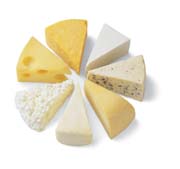
While yield and quality are basic requirements for consistent cheese production, ripening is the cornerstone in making excellent Cheddar. Cheddar cheese may be made by a number of related processes. Creating the desired flavor in these cheeses requires balancing the flavor by using the proper acidifying cultures, enzymes and ripening temperatures. Addition of adjunct cultures can enhance the flavor development rate and improve the balance of the flavor, no matter which process is used.
When cheese is made, chymosin starts a limited conversion of the casein to large peptides. The proteases of the starter bacteria then convert some casein and the large peptides into smaller peptides. The peptides can then be converted into free amino acids by the peptidases and aminopeptidases from the primary starter bacteria. The peptides can help create a desirable flavor or a very bitter cheese depending on the type of protease and concentration of the enzymes. When the protease concentration is high compared to the amount of peptidase and aminopeptidase, the result is bitter cheese. An insufficient amount of both protease and peptidase results in cheese with delayed flavor development.
The handling and storage of cheese during ripening generally involves great expense. In addition, the current volatile cheese market increases the financial risks to the cheesemaker trying to forecast prices almost a year in advance. Many researchers have tried adding enzymes directly into the cheese milk. Unfortunately, these enzymes may also affect the cheese yield and be lost in the whey. Addition of enzyme preparations to the curd has often resulted in uneven flavor development and discoloration of the cheese due to localized stimulation of the culture.
During recent years, considerable effort has gone into research and development of special adjunct cultures that give superior control over the ripening process. The desirable characteristics of the final product are retained while reducing ripening time and expense. Added with the primary starter culture, they are evenly distributed in the curd. Since they do not ferment lactose, they do not significantly change the acidification process or the current cheese make schedule.
Adjunct cultures were selected to produce high levels of selected proteinases and peptidases. The adjuncts are inactivated during pasteurization of the whey much like primary starter cultures. The adjunct cultures are in effect enzyme capsules that are activated in the cheese in a natural way. These cultures intensify the ripening process by providing more of the enzymes that are traditionally used to ripen cheese. They provide distinctive savory, sweet or nutty flavor notes. Adjusting the amount of culture and the ripening temperature schedule can control the culture's flavor developing enzymes.
Lipase and esterase enzymes produced by select Lactobacillus helveticus strains can also accelerate the development of flavors in some cheeses. These enzymes hydrolyze the milkfat, creating select free fatty acids. The fatty acids produce characteristic flavors but are also the raw material for ester production. Esters are combinations of free fatty acids and alcohols that provide fruity notes to some cheeses like Parmesan and Swiss and are background notes in Cheddar.
One unique culture on the market is Emfour™, which is manufactured by Chr. Hansen Inc. The product contains a combination of L. helveticus and Lactobacillus acidophilus, with the latter not traditionally used in making cheese. The culture produces cheeses with a unique flavor profile and significantly enhanced mature and nutty tones. The cheeses are firm with underlying sweet, sour and salt flavors. Tyrosine crystals, which are characteristic of many long-hold cheeses, may appear, depending on ripening conditions.
It is now possible for dairies to produce cheeses that meet a specific market demand. In an increasingly competitive world, many are realizing that the answer lies in developing novel products or traditional products in novel ways.
